Today, we're going to cook the traditional Filipino Abuos. After years of perfecting this unique dish, I'm excited to share my take on this mountain delicacy with you.
Abuos are delicate ant eggs that offer an incredible blend of gooey and crunchy textures, with a flavor profile that's often compared to fine caviar. This quick 30-minute recipe transforms these special ingredients into a showstopping dish using just a handful of common pantry staples like garlic, onions, and soy sauce.
My simple cooking method preserves all the unique qualities that make Abuos the "caviar of Ilocos" while making it approachable enough for anyone to prepare at home.
What is Abuos?
Abuos is a Filipino delicacy made from the soft white larvae (eggs) of red weaver ants. Known as the "caviar of Ilocos," this mountain delicacy from Northern Luzon has been treasured for generations. The eggs are carefully harvested from ant nests and are prized for their unique flavor profile and cultural significance.
In Filipino mountain communities, Abuos symbolizes heritage and togetherness, making it not just a meal but a connection to rich culinary traditions.
Jump to:
Why You'll Love This Recipe
You'll fall in love with this traditional Abuos recipe for its unique combination of flavors and textures that can't be found in any other dish. The delicate, slightly sour taste of these ant eggs creates a gourmet experience often compared to caviar.
Each bite offers a fascinating contrast of gooey and crunchy textures that make this dish truly special. Not only is this recipe a conversation starter at any gathering, but it's also packed with protein and nutrients, making it as nutritious as it is delicious.
By preparing this dish, you're connecting with centuries of Filipino mountain community traditions and experiencing a true culinary adventure.
Ingredients
I've carefully selected each ingredient in this recipe to highlight the natural delicate flavor of Abuos while creating a balanced dish. The aromatic garlic and onions create a savory base that complements the ant eggs without overpowering them.
Soy sauce adds just the right amount of umami and saltiness, enhancing the natural nutty undertones of the Abuos. The optional vinegar brightens the dish with a subtle tang, while fresh tomatoes provide a juicy sweetness that balances the savory elements.
Finally, spring onions add a fresh, crisp finish that elevates the entire dish while adding beautiful color contrast to the white Abuos.
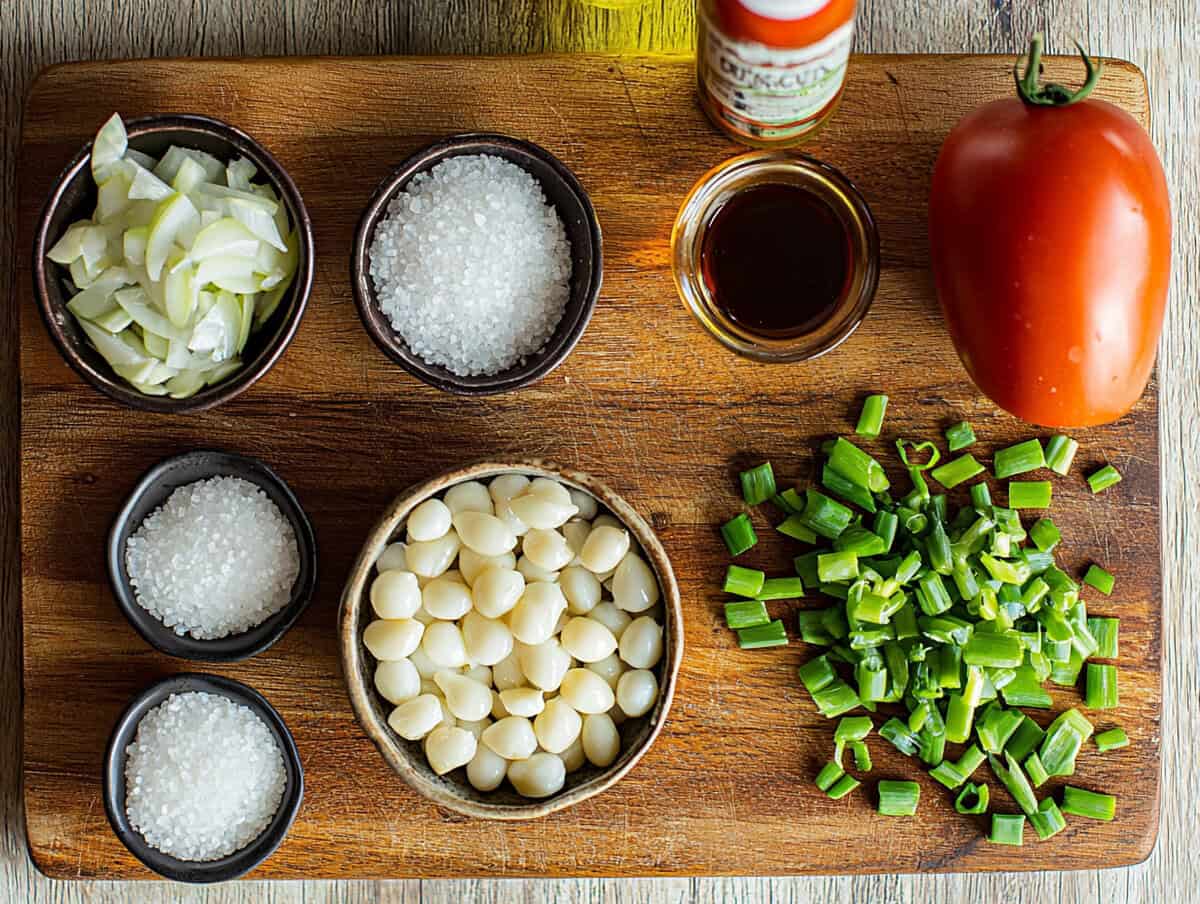
- 1 cup fresh Abuos (ant eggs/larvae)
- 3 cloves garlic, minced
- 1 small onion, finely chopped
- 2 tablespoons cooking oil
- 1 tablespoon soy sauce
- 1 teaspoon vinegar (optional)
- Salt and pepper to taste
- 1 tomato, diced (optional)
- 2 tablespoons chopped spring onions for garnish
Equipment
- Small non-stick pan
- Wooden spatula
- Fine-mesh strainer
- Small bowl
- Serving plate

How To Make
- Clean the Abuos by placing them in a fine-mesh strainer and gently rinsing with cold water to remove any debris or adult ants. Be very gentle to avoid crushing the delicate eggs.
- Pat dry the Abuos using a paper towel or clean kitchen cloth.
- Heat oil in a small non-stick pan over medium heat.
- Sauté garlic and onions until fragrant and translucent, about 2 minutes.
- Add the Abuos to the pan and gently stir, being careful not to crush them.
- Cook for 3-4 minutes until they start to turn slightly opaque.
- Add soy sauce and continue cooking for another 2 minutes.
- Season with salt and pepper to taste. Add vinegar if using.
- If using tomatoes, add them now and cook for just 1 more minute.
- Turn off heat and transfer to a serving dish.
- Garnish with chopped spring onions and serve immediately.

Tips from Lola's Kitchen
- Freshness matters: For the best flavor, cook Abuos on the same day they are harvested or purchased.
- Gentle handling: Treat the Abuos with care when cleaning and cooking to maintain their delicate texture.
- Perfect pairing: Abuos goes wonderfully with a side of steamed rice and a cold beer or rice wine.
- Quick cooking: Don't overcook the Abuos as they can become tough and lose their distinctive texture.
- Seasonal timing: Remember that Abuos is only available for a short 11-15 day harvesting window, so enjoy them when you can!
Substitutions
- No Abuos available? While there's no perfect substitute for the unique flavor of Abuos, small fish roe can provide a similar textural experience.
- Soy sauce alternative: Use fish sauce (patis) for a more traditional Filipino flavor profile.
- Garlic and onions: If you prefer a milder flavor, use shallots instead of regular onions.
- Low-sodium option: Replace regular soy sauce with a low-sodium version if you're watching your salt intake.
Troubleshooting
- Abuos breaking apart: You may be stirring too vigorously. Use gentle folding motions instead.
- Too salty: Balance the saltiness with a squeeze of calamansi or lemon juice.
- Too bland: Add a bit more soy sauce or a pinch of MSG to enhance the umami flavor.
- Adult ants in the mix: Take more time during the cleaning process to ensure all adult ants are removed before cooking.
Storage & Reheating
- Fresh is best: Abuos is ideally consumed immediately after cooking.
- Short-term storage: If necessary, store leftovers in an airtight container in the refrigerator for no more than 24 hours.
- Reheating: Gently warm in a pan over low heat just until heated through. Avoid microwaving as it can make the texture rubbery.
- Not freezer-friendly: Due to their delicate nature, Abuos do not freeze well and will lose their distinctive texture.
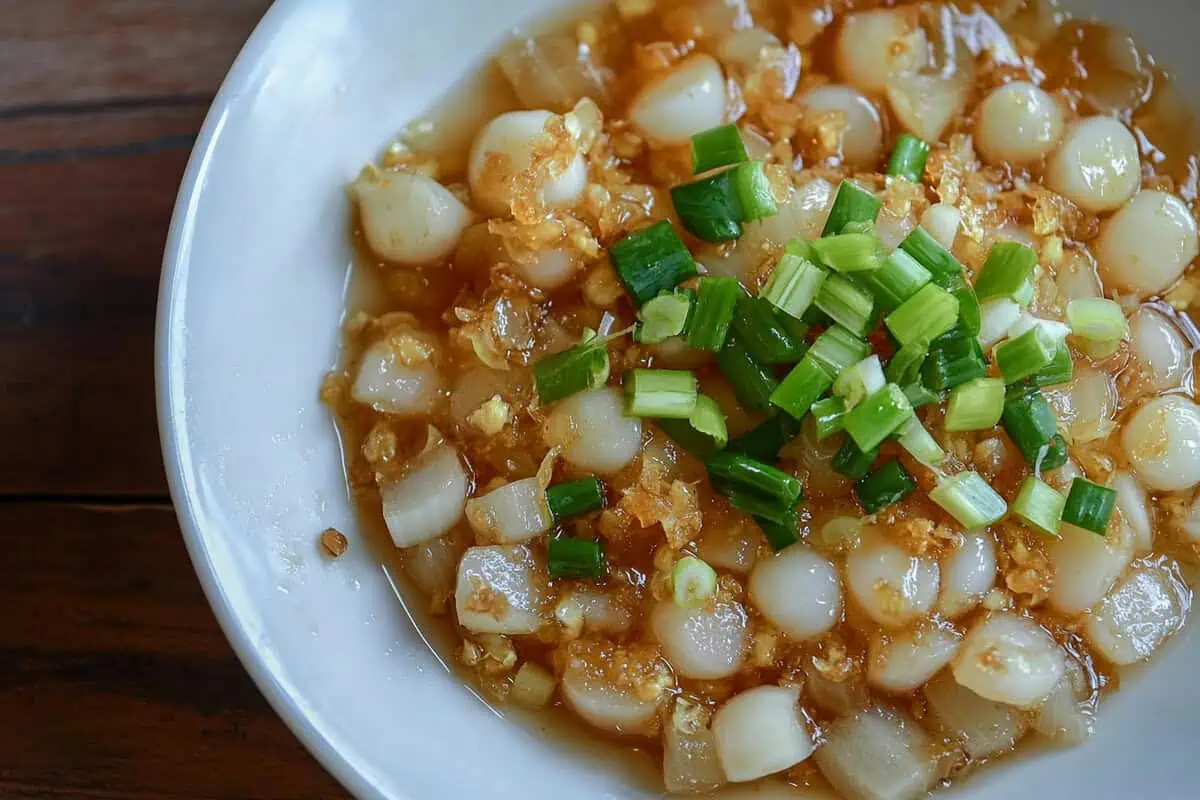
FAQ
Are ant eggs really edible?
Yes, ant eggs or Abuos are completely edible and considered a delicacy in many parts of the Philippines, particularly in the Ilocos region.
What do Abuos taste like?
Abuos have a delicate, slightly sour taste with nutty undertones and a rich umami flavor when cooked. Their texture is uniquely gooey yet crunchy.
Where can I find Abuos?
Abuos can be found in public markets and specialty restaurants in Ilocos, Philippines. They're seasonal and typically only available for a short 11-15 day period during the harvesting season.
Are Abuos nutritious?
Yes, Abuos are high in protein and contain various essential nutrients. In Filipino culture, they're also believed to have aphrodisiac properties.
Can I eat Abuos raw?
While some enthusiasts enjoy fresh Abuos similar to how one would eat caviar, it's generally recommended to cook them to ensure safety and enhance their flavor.
How do I know if Abuos are fresh?
Fresh Abuos should be soft, white, and intact. They should have a clean smell without any sourness or off odors.
Related
Looking for other recipes like this? Try these:
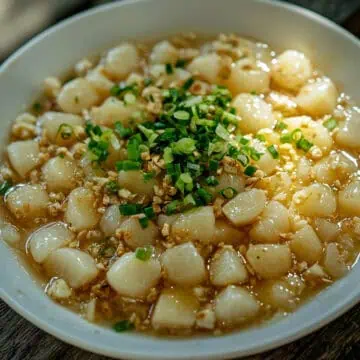
Abuos Recipe (Ant Eggs Delicacy)
Ingredients
- 1 cup fresh Abuos ant eggs/larvae
- 3 cloves garlic minced
- 1 small onion finely chopped
- 2 tablespoons cooking oil
- 1 tablespoon soy sauce
- 1 teaspoon vinegar optional
- Salt and pepper to taste
- 1 tomato diced (optional)
- 2 tablespoons chopped spring onions for garnish
Instructions
- Clean the Abuos by placing them in a fine-mesh strainer and gently rinsing with cold water to remove any debris or adult ants. Be very gentle to avoid crushing the delicate eggs.
- Pat dry the Abuos using a paper towel or clean kitchen cloth.
- Heat oil in a small non-stick pan over medium heat.
- Sauté garlic and onions until fragrant and translucent, about 2 minutes.
- Add the Abuos to the pan and gently stir, being careful not to crush them.
- Cook for 3-4 minutes until they start to turn slightly opaque.
- Add soy sauce and continue cooking for another 2 minutes.
- Season with salt and pepper to taste. Add vinegar if using.
- If using tomatoes, add them now and cook for just 1 more minute.
- Turn off heat and transfer to a serving dish.
- Garnish with chopped spring onions and serve immediately.
Tips from Lola's Kitchen
- Freshness matters: For the best flavor, cook Abuos on the same day they are harvested or purchased.
- Gentle handling: Treat the Abuos with care when cleaning and cooking to maintain their delicate texture.
- Perfect pairing: Abuos goes wonderfully with a side of steamed rice and a cold beer or rice wine.
- Quick cooking: Don't overcook the Abuos as they can become tough and lose their distinctive texture.
- Seasonal timing: Remember that Abuos is only available for a short 11-15 day harvesting window, so enjoy them when you can!
The Story Behind Abuos
In the lush mountain regions of Northern Luzon, Philippines, a culinary tradition unlike any other has been quietly thriving for generations. Abuos, the delicate eggs of red weaver ants, emerged as a prized delicacy among the Ilocano people long before modern cuisine took notice. This remarkable food journey begins in the dense forests where these industrious insects build their intricate nests.
The practice of harvesting and cooking Abuos dates back centuries in Filipino mountain communities. What began as a practical source of protein for isolated villages evolved into a celebrated culinary tradition. Elders in these communities passed down specialized harvesting techniques designed to collect these precious eggs without destroying the ant colonies or disrupting the delicate forest ecosystem.
In Ilocos, Abuos isn't just food—it's a cultural symbol of heritage and resilience. Often referred to as the "caviar of Ilocos," this delicacy earned its prestigious nickname not just for its textural similarities to fish roe, but for its rarity and seasonal availability. The limited 11-15 day harvesting window creates anticipation throughout the region, with families marking their calendars for this special culinary event.
Traditional Filipino celebrations in mountain communities often feature Abuos as a symbol of prosperity and abundance. Wealthy families proudly serve this delicacy during fiestas, while community gatherings center around the shared experience of enjoying this seasonal treat. The presence of Abuos on a table signifies not just a meal but a connection to the land, ancestors, and Filipino cultural identity.
The journey of Abuos from forest to plate represents Filipino culinary ingenuity at its finest. Early cooking methods were simple—focused on preserving the delicate flavor and unique texture of the eggs rather than masking them. Over time, the classic preparation with garlic, onions, and soy sauce emerged as the perfect combination to enhance the eggs' natural qualities while maintaining their distinctive character.
Today, Abuos continues to captivate adventurous eaters and culinary enthusiasts worldwide. As interest in traditional and indigenous foods grows, this mountain delicacy serves as a powerful reminder of the Philippines' rich biodiversity and the deep cultural connections between food, community, and environment. With each carefully prepared serving, we honor not just a unique ingredient, but the generations of Filipino wisdom that transformed these tiny eggs into a celebrated culinary treasure.
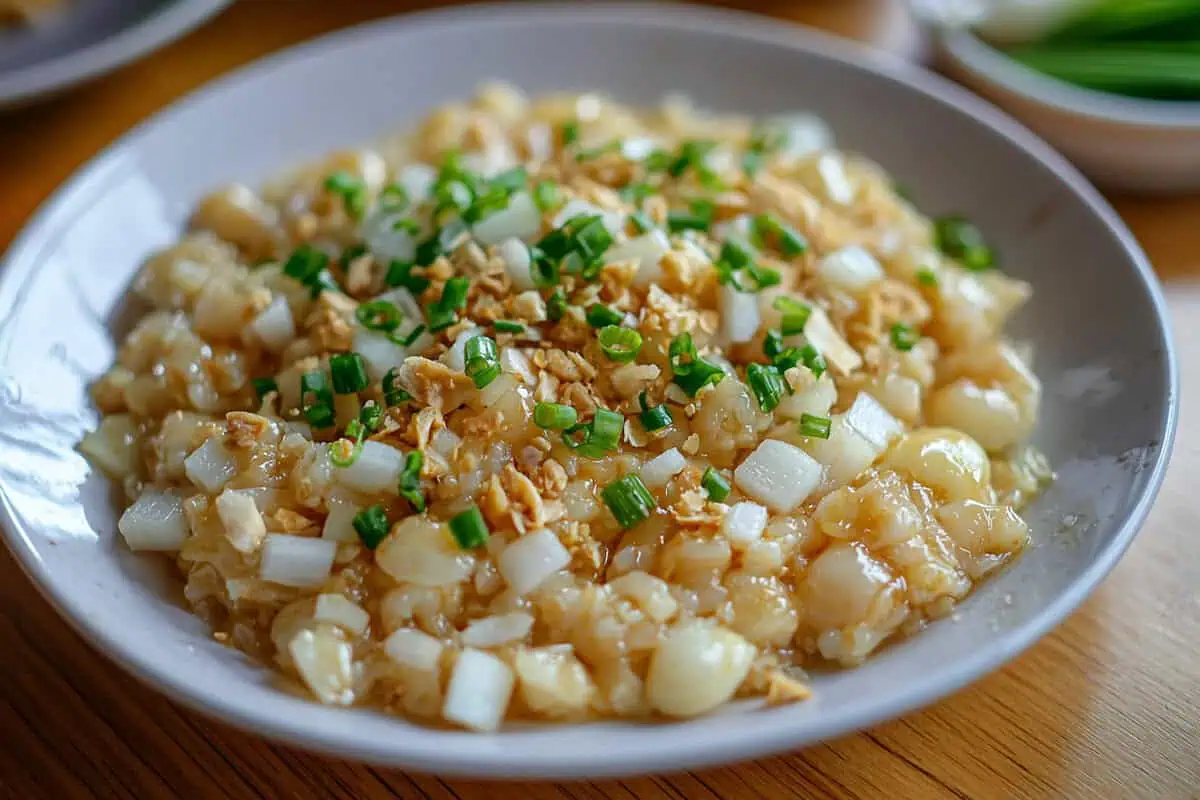





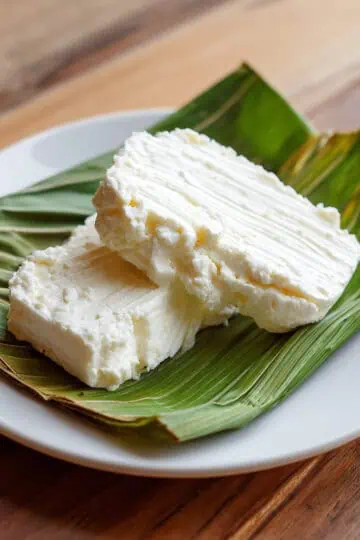
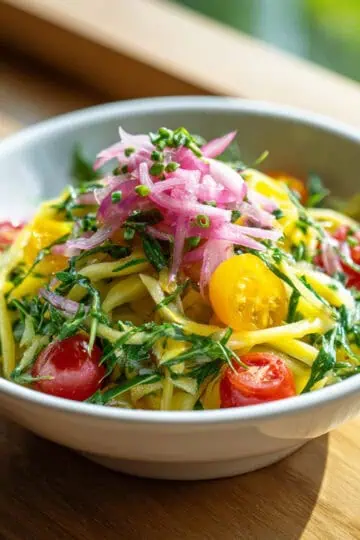
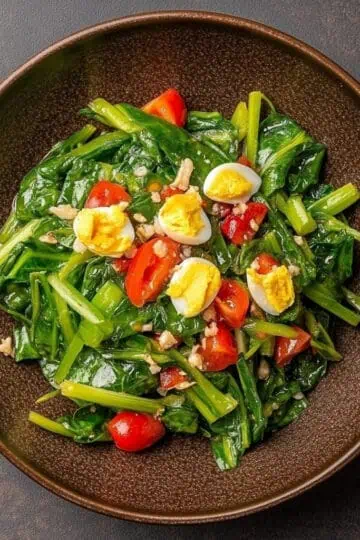

Comments
No Comments